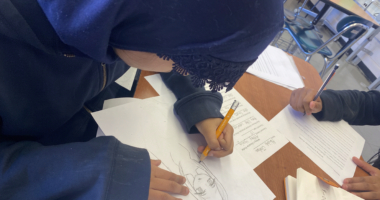In this ongoing series, Katie Rainey, reports from inside the Teaching Artist Training and Internship Program. A graduate of the program, Katie shares her insight into the workshops, seminars and personal experience with classroom internships.
Saturday, November 1, 2014, Community-Word Project’s 25-week Teaching Artist Training & Internship Program (TATIP) held the second in a series of workshops for beginning and advanced Teaching Artists. The hot topic of the day was Lesson Planning. The workshop was structured like a model lesson plan with Patti Chilsen and Renee Watson as the lead facilitators.
The Inquiry Question
How can Teaching Artists effectively prepare Lesson Plans in order to concretely translate artistic goals in the classroom?
The Opening Ritual
Like any good lesson plan, the workshop began with a series of warm-ups, introductory and community-building activities. A staple warm-up at Community-Word Project might include stretching, talking and reflecting. Another all-time favorite is the Graffiti Wall.
A Graffiti Wall is chart paper hung on the wall with a word, phrase or image in the center. Students consider the word and write what they feel about it on the remaining paper space. This strategy gets students in the mindset for creating. Away from those conditioned thoughts that come with everyday school life.
Introductory Activity
The warm-up complete, we began with an introductory activity before we segue into the main lesson. This is called scaffolding a lesson plan, or working from one lesson plan building block to the next. It is an important tool for Teaching Artists.
Renee began by talking about sensory details. She used a Brainstorming Worksheet to get participants to think about their childhoods. What did they remember? What foods did they eat? What type of music did they like?
“Good poetry can paint a vivid portrait of a scene, emotion or similar subject matter with words. Students who are beginning to master the basics of different types of poetry often get stuck focusing on the rhyme scheme or rhythm of the poem, but rich sensory imagery can be just as important as proper meter.”
Main Activity
The main activity was a reading of the poem, “Raised by Women” by Kelly Norman Ellis. We listened once to the poem. Then acted out movements and voices while taking turns reading it aloud. Lastly we spoke about what was memorable and what senses we experienced in the poem.
Renee showed that approaching the poem from various angles appeals to classrooms of students with varying multiple intelligences. Students often have different ways of learning. The term multiple intelligences indicates the various ways they learn: musical–rhythmic, visual–spatial, verbal–linguistic, logical–mathematical, bodily–kinesthetic, interpersonal, intrapersonal, and naturalistic. Each individual possesses a unique blend of all the intelligences. This model was proposed by Howard Gardner in his 1983 book Frames of Mind: The Theory of Multiple Intelligences.
Next it was time for some serious writing. We tried our hands at our own “Raised by…” poems and the results were as astounding as they were different in their approach. Using ideas from the childhood memory brainstorming worksheet, the poems elicited laughter, contained electric descriptions and rich sensory details. There were inspired, heartbreaking lines and even a few tears.
After a welcome lunch break, the group was divided into five teams in order to create and perform a Community Poem. Everyone selected a favorite line from their poem and combine it with a larger, group effort. Taking words from the page to the stage, however, isn’t an easy task. Each group was given time to write, edit and rehearse their collaborative poems. Teams were also tasked with including “secret ingredients” to their performances. Some teams added music, others movement, repetition, levels, etc. Each team then performed their collaborative piece for the group.
Working on the Community Poems was not only a great way to connect with the other teaching artists in the program, but it was also informative in the context of the classroom and ensuring that all students’ voices are heard. The exercise made me realize how paramount it is to make every individual feel that their story deserves to be shared; it creates a safe space and fosters community. The communal building of the poems also intimated an idea of being part of a meaningful whole; the poem could not be completed without collaboration and appreciation of each other’s contributions. In a classroom setting, if the students understand that their work can influence others, they have a greater sense of responsibility and pride in the effort they put into their classwork. – Ally Tufenkjian, Theatre Artist

Reflection
The last hour of the workshop was dedicated to unpacking the day’s lesson plan and reflecting upon our artistic choices throughout the day. The discussion touched on the contents of the days lesson plan as well as a meta examination of the techniques used in the workshop with a eye toward the classroom and student learning. The facilitators primarily employed modeling to bring home the methods used in the creation and execution of a lesson plan.
I found this workshop incredibly helpful in my progression as a teaching artist. Specifically, the conversation on intangible goals vs. measurable goals in the class objectives for the day. I never really considered how the measurable goals can both help reach the intangible goals, and provide a scale to demonstrate my successes and weaknesses in the classroom for that day. – Nabila Lovelace, Writer
The Closing Ritual
In order to close out the workshop and end the day in a meaningful way, participants rose and said in unison:
I have a voice!
My voice is powerful!
My voice can change the world!
Stay tuned for our next workshop
The third installment of TATIP 2014-15 will see the Advanced trainees break away to discuss Curriculum Development, Student Assessment, Igniting the Spark and Reflection. The beginning trainees will begin the process of developing lesson plans with their teaching partners.



